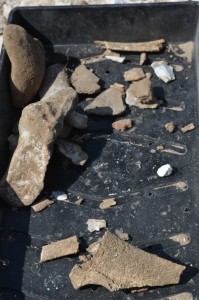Progress of the excavation
Today, everyone returned to the task of ‘cleaning back’, which had reached its final stages by the afternoon. Once this was completed, pairs of students were tasked with firstly strongly defining the edges of each of the features, followed by their identification and sectioning, in order to enable their viewing in a vertical plane once the process of excavation was complete. This enables effective interpretation of the stratigraphy of a feature(s) and aids an estimation of the relative chronology of the feature(s). Having fully revealed the potential archaeology underneath the top soil and defined it, mapping grids were placed around both of the trenches and surveyed through the use of GPS systems, in order to allow precise recording of the position of each of the features.
This will also allow the composition of a more comprehensive digitial image of the site in the future, enabling a more detailed analysis of any temporal patterns observed within the location of settlement areas.
Further artefacts in the form of faunal remains and ceramic sherds were discovered in significant quantities around both of the trenches and Trench A supervisor, Harry Manley, experessed that finds, appearing in many of the semi-circular features, such as fragments of Black Burnished Ware and South East Dorset Orange Wiped Ware allowed for a continually more confident diagnostic of the site, due to their occurrence at many sites dated to the Late Iron Age. Scarce numbers of worked flint were also recovered, further supporting the gathering evidence for the site’s past use for settlement and metal detection carried out over the spoil heap produced finds of iron nails, also originating within the Late Iron Age. As hoped, environmental sample flotation began today and the first samples were taken from the excavated contexts of features in Trench A.
Similarly, in Trench B, ceramic sherds and faunal remains in the form of bone fragments and teeth had been discovered. However, slag and fragments of tuyere (a pipe through which a furnace receives oxygen in order to achieve a high enough temperature for the smelting of metals such as Iron) were also discovered while troweling back the surface of an amorphously shaped feature. The presence of these could infer that the excavation may be embarking upon the site of past metallurgic production and working. Moreover, a further two ring ditches (circular features smaller than the Iron Age round house) had also been observed and the excavation of the potential metallurgic working hollow commenced.
Other responsibilities around the site
Contrary to manual excavation and environmental sampling, the processing of finds had also taken place. The intricate and delicate washing of finds allows for a more detailed understanding of their origin as well as greater recovery of information about their importance.
Furthermore, a complete record of all the finds, including where they were found, what material they were composed of and possible dating must be kept in order to be able to fully utilise the data for analysis of the site. As there had been a backlog within both; the processing of the finds as well as their sorting and administrative recording from the past seasons of the excavation, it was imperative to revisit the previous collections and to re-model their organisation. This was done by methodically checking each of the bags, weighing and counting each of the finds as well as sorting them by the material type that was present (and placing in separate bags if they had previously been mixed), as well as noting any particularly significant finds and recording on the record sheet relevant to the year of excavation.
This task required a great attention to detail and allowed a broader depth of understanding of the finds as well as methods of distinction between different types of material.
